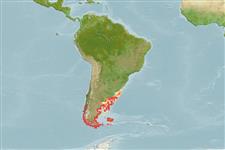Environment: milieu / climate zone / depth range / distribution range
Écologie
marin benthopélagique; profondeur 0 - 250 m (Ref. 127764). Temperate; 32°S - 57°S, 76°W - 53°W
Southeast Pacific and Southwest Atlantic: Valparaíso, Chile and Patagonian region of Argentina to Tierra del Fuego.
Taille / Poids / Âge
Maturity: Lm ? range ? - ? cm
Max length : 90.0 cm TL (female); poids max. publié: 0.00 g
Épines dorsales (Total) : 7 - 8; Rayons mous dorsaux (Total) : 23 - 27; Épines anales: 0; Rayons mous anaux: 0. Caudal fin emarginate. Body blue brown dorsally and silvery yellow ventrally. First and second dorsal fins grayish, caudal fin brownish, their distal parts yellowish. Anal fin pale brown (Ref. 27363).
Life cycle and mating behavior
Maturité | Reproduction | Frai | Œufs | Fécondité | Larves
Corporacion de Fomento de la Produccion (Chile), 1980. Catálogo de recursos pesqueros Chile. Instituto de Fomento Pesquero, Gerencia de Desarollo, CORFO, Santiago, Chile. (Ref. 5964)
Statut dans la liste rouge de l'IUCN (Ref. 130435: Version 2024-2)
Menace pour l'homme
Harmless
Utilisations par l'homme
Pêcheries: intérêt commercial mineur
Outils
Articles particuliers
Télécharger en XML
Sources Internet
Estimates based on models
Preferred temperature (Ref.
123201): 7 - 16.1, mean 10.7 °C (based on 172 cells).
Phylogenetic diversity index (Ref.
82804): PD
50 = 1.5000 [Uniqueness, from 0.5 = low to 2.0 = high].
Bayesian length-weight: a=0.00977 (0.00430 - 0.02222), b=3.06 (2.85 - 3.27), in cm total length, based on LWR estimates for this (Sub)family-body shape (Ref.
93245).
Niveau trophique (Ref.
69278): 3.5 ±0.41 se; based on food items.
Generation time: 7.8 ( na - na) years. Estimated as median ln(3)/K based on 1
growth studies.
Résilience (Ref.
120179): Milieu, temps minimum de doublement de population : 1,4 à 4,4 années (Assuming tm <4).
Fishing Vulnerability (Ref.
59153): High vulnerability (61 of 100).
Climate Vulnerability (Ref.
125649): Very high vulnerability (100 of 100).
Nutrients (Ref.
124155): Calcium = 15.3 [9.6, 26.5] mg/100g; Iron = 0.224 [0.142, 0.358] mg/100g; Protein = 17.9 [17.1, 18.8] %; Omega3 = 0.517 [0.296, 0.895] g/100g; Selenium = 18.6 [9.9, 36.3] μg/100g; VitaminA = 17.4 [5.3, 57.2] μg/100g; Zinc = 0.557 [0.408, 0.774] mg/100g (wet weight);
